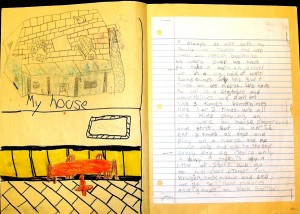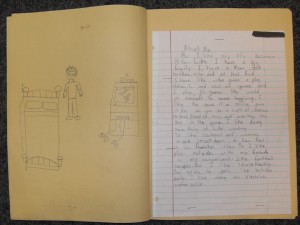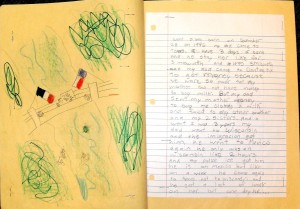Immigration Stories: Students Write about Their Journeys to America
By Ragina Shearer
Growing up in the seventies, I was constantly frustrated in my Grade 6-12 “Reading” classes, because we never read. Day after day we worked on skill after skill, and when it appeared we were actually going to read something, it was “Round Robin” style. Awaiting my turn to read, I remember listening to students struggle over the words or to the timid voices of students whose voices I could barely hear. Consequently, I usually lost interest in the story. I do not remember the teacher reading aloud to us or even introducing stories that were stimulating or challenging. Fortunately, I was an avid reader on my own and knew the excitement and pleasure that could be found in literature.
When I became a teacher eighteen years ago, I knew that one of my top priorities would be to share my love for reading with my students. As a teacher of various grade levels, I have taken my students on many literary adventures. I have found reading aloud to my class to be a valuable asset across content, genre, and grade levels. Currently, I teach reading and language arts in a middle school to sixth and eighth grade English Language Learners (ELLs). My students are primarily Latino, mostly from Mexico, another from Honduras and one from Austria. Together we share in the excitement when I read aloud from culturally relevant literature. They bubble over with excitement, always eager to tell their own stories and to share from their personal experiences.
Recently, I read two picture books to different groups of students, both on the topic of immigration. The first one was Ziba Came on a Boat by Liz Lofthouse (2007). The book never directly states the location of the girl’s home that she is leaving nor the new home where she is going, however, it is implied through the descriptions in her words and the beautiful illustrations that her home was in the Middle East, specifically Afghanistan, and that she is going to Australia, the home of both the author and illustrator of the book. The entire story is set on the boat. At the beginning of the story, Ziba is remembering the home she has left behind. Thoughts of both of her parents blend into the array of memories of her homeland. Even though her memories are fond, she also remembers the gunfire and the fearful night of her escape along with her mother. Her father did not flee with Ziba and her mother and he is not on the boat. No reason is given in the book, so the reader must make his own inference about the father’s disappearance. Through her mother’s inspiring hope of freedom, Ziba shares her dreams about the new world and new home she will have soon.
I read this book to my class of sixth grade ELLs. Throughout the book as I read about Ziba’s memories, I prompted my students to share memories they had of the home they left before coming to the U.S. They eagerly raised their hands and bounced in their seats awaiting their turn. One by one they shared comments about the home and family they left behind. I heard comments such as, “When we left my grandmother cried,” “My cousins and I use to walk to the Ortega’s store everyday to buy candy,” “I miss having my cousins to play with,” “My mom and grandpa and I use to eat tacos at a store on our street,” “My grandmother use to sing to me all the time and we would watch the stars together.” One boy with tears in his eyes stated that he had to leave his dog, Barney, in Mexico. They were all so eager to share their memories, and I assured them that they would have a chance to share all of these interesting memories in stories we were about to write. In one of the written stories, Maria wrote,
My important memory was when I was little. I lived in Melchor Musquis Cahuila. I remember when I went to my grandmother’s house and my aunt’s ranch. I remember swimming at the lake with daddy and riding in the back of the truck. I miss my grandpa, my aunts and uncles, my cousins. But I’m here with my family. We were not together, but now we are. We are whole again. I have new friends, new cousins and a new life everyone so nice. Why who knows who cares my dad has a great job. Before he came he work in grandpa’s backyard. My mom work in Mexico, but here she doesn’t work she cleans and care us. We learn new stuff. I will never forget my grandma and grandpa. I will like to see them again.
Jose used his writing to connect to the war Ziba was escaping by telling us his grandfather’s story about escaping from a war in El Salvador. Jose shared with us that his grandfather used to tell him that was how his family first came to Mexico.
Later, as we read about Ziba approaching her future home, I asked my students to share what they remembered about their thoughts of arriving in this country. Once again hands went up and students shared their expectations and their fears. Thomas said, “It took way too long to get here.” Maricela said she liked her old house and she was afraid she would not like the new one, but she assured us she does. Many agreed they were afraid people would be mean, talk weird, not like them, and they were worried about school. Isabel commented that once she came to school she was not afraid anymore because the teachers and students were nice and helpful. Other students joined in with comments about how they liked the food in the cafeteria and how there was always someone who could help them and fun things to do.
On each occasion my students eagerly shared memories that appeared to be still vivid to them. When we finished reading the book and sharing in discussions, the students each created a replica of Ziba’s boat out of Manila paper. We discussed the fact that many, if not all of them, may never have been on a boat like this, but all of them had left a home, a country, and possibly some family members. I asked the students to think about the memories that were special to them about the place they left behind and on one side of the boat to write a story about those special memories of the home they left. Finally, I engaged the students once again in thinking about their hopes, dreams, and fears of the new home as they were coming to the U.S. After a short discussion, I instructed the students to turn on the opposite side of the boat and write a second story, this time about their hopes, dreams, and fears of their new home, before they arrived here. One student, Erica, a soft spoken and quiet girl, wrote about her fears, reflecting conversations she had heard from her parents and other adults.
That place is free to do whatever we want. Somewhere me and my family won’t be separated. A place with great people, and leader. A great providence of food and land. A place with no affairs. I wish we never be separated, and find a good life. A place where we’ll be treated nicely. Somewhere that can let go free. Don’t be treat in a bad way just because we’re different. I think would be happy.
Samuel expressed his greatest fears as he wrote, “I hope they won’t kill us in the U.S.” Many students wrote about worrying if people would laugh at them because they looked different or their clothes were different. Jesus said he was worried because people in the U.S. talk different and he would not know what they were saying. Grinning he said, “But I speak English now so I know what everyone is saying.”

In a reading class of mixed sixth and eighth grade ESL students I read Immigrant Girl: Becky of Eldridge Street by Brett Harvey. This book is about a Russian immigrant girl who is living in New York City. She tells about her daily life in her new home and compares it to the life she remembers in her home in Russia. Throughout the reading of this book the students and I engaged in conversations about their own feelings toward their new home and the one they left behind. The students told a lot about their homes in their former countries and compared them to their homes in the U.S. They also spoke openly, comparing daily events from their home countries to their daily lives now. I prompted students to think about their trip from their home country to the U.S., even though that particular piece was not in this book. The students enthusiastically shared stories and listened to and questioned one another. Over the next few days, I had my students write stories about their native homelands, their journeys to America, and their homes and their lives as they were now in America. After several days of writing, more discussions, and re-reading of the book each of my students had several stories completed. The students placed these stories into booklets, in sequential order, and illustrated each of their stories.
Miguel drew the outside and inside of his house and wrote a story comparing his old house in Mexico to his new one.
In Mexico we were poor we have to take a bath on a river or in a big hold of water sometimes only like three or four times on our house. Here we bathe in our house every day. We have to eat in a big table and sometimes we don’t eat like three times like one or two times only in Mexico. Here we eat three times a day. We go to Wal Mart, Target, Kroger, and Sack n Save.

Tony wrote about his journey to America from Honduras.
At 2005 I was eleven. I went to my neighbor country, El Salvador. There was very cheap and big. After one year I went to Mexico. There is very nice people, but very expensive. At night Mexico City, Mexico is very beautiful. After one year again I went to Honduras. At 2008, January 8th I went to United State America to learn English and lot things. I couldn’t bought hamburger in Mc Donald when I came to U.S.A. but now I can. And I’m in U.S.A. now.

Pedro shared a story full of struggles during his family’s immigration to the U.S.
When I was 3 years my dad went to Wisconsin and the immigration got him. He went to Mexico again he only was on Wisconsin like two hours and the police got him. He is in Mexico about like one week. He came again to Texas, not Wisconsin and he got a lot of work but one day he broke his foot and he go to the hospital and he have to pay a lot of money. All the money that he had worked for.

Even though none of my students immigrated in the same manner or from the same countries as the girls in these two stories, they all could relate to the stories in connected and personal ways. Each felt compassion for the character in the story and felt deep empathy towards the feelings shared by the character. Ana shared in her stories how she always wanted to be a nurse when she grew up and that she knows she will be able to do this in America. Maria wrote about a dream shared by her and her twin brother of having a family of their own and always being neighbors in America. All of my students shared in their writings not only about the dreams they had of a good life when they came to America, but also about the dreams they still had, along with many of their parents, about the good life they were still in the process of working to build as they enjoyed their life in the U.S.
As teachers, we should always try to learn as much as we can about each student and his heritage. With the diversity of backgrounds in today’s classrooms that include many immigrant experiences, discovering individual cultures is not always an easy task. Culturally relevant literature has the potential to invite ELL students to explore the connections between their past life experiences and the communities in which they live. By providing literature in which they can see themselves and their own experiences, we encourage them to be proud of and to share their own stories orally and in writing. This will build a positive learning environment and boost our students’ self-images.
Other books I have found to be successful in reading and writing with students:
- Bunting, E. (1996).
Train to somewhere
- . Ill. by Ronald Himler. New York: Clarion.
- Hanson, R. (2005).
A season for mangos
- . Ill. by Eric Velasquez. New York: Clarion.
- Leighton, M. R. (1992).
An Ellis Island Christmas
- . Ill. by Dennis Nolan. New York: Puffin.
- Mora, P. (1997).
Tomás and the library lady
- . Ill. by Raúl Colon. New York: Knopf.
- Pearl, S. (2007).
Books for children of the world the story of Jella Lepman
- . Ill. by Danlyn Lantorno. Gretna: Pelican.
- Rodriguez, L. J. (1954).
America is her name
- . Willimantic: Curbstone Press.
References
Harvey, B. (1987). Immigrant girl: Becky on Eldridge Street. New York: Holiday.
Krashen, S. D., Tse, L., & McQuillan, J. (1998). Heritage language development. Culver City: Language Education Associates.
Lofthouse, Liz. (2007). Ziba came on a boat. La Jolla, CA: Kane/Miller.
Murphy, R. J., Jr. (1999). On Stories and Scholarship. In R. L. Graves (Ed.), Writing, teaching, learning 4th edition of rhetoric and composition. Portsmouth, NH: Boynton/Cook.
Ragina Shearer is a teacher at McMath Middle School, Denton, TX.
WOW Stories, Volume II, Issue 2 by Worlds of Words is licensed under a Creative Commons Attribution-NonCommercial-ShareAlike 4.0 International License.
Based on a work at https://wowlit.org/on-line-publications/stories/storiesii2/.
